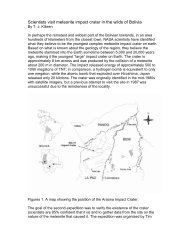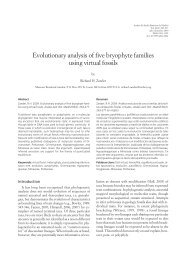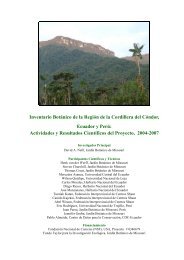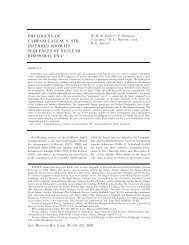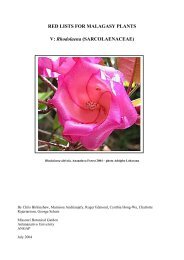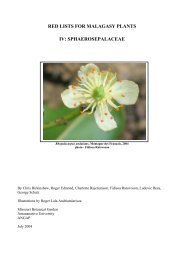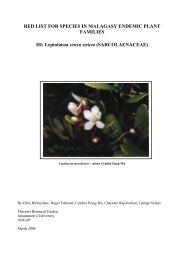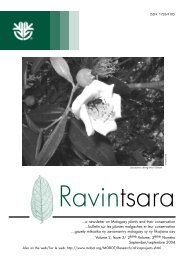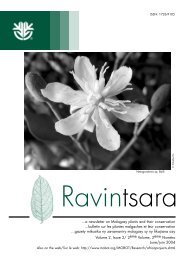The Caucasus - Missouri Botanical Garden
The Caucasus - Missouri Botanical Garden
The Caucasus - Missouri Botanical Garden
Create successful ePaper yourself
Turn your PDF publications into a flip-book with our unique Google optimized e-Paper software.
Russia Turkey <strong>The</strong> <strong>Caucasus</strong><br />
Biodiversity Hotspot<br />
Members of the Russian Federation, including Adygeya,<br />
Chechneya, Dagestan, Ingushetia, Kabardino-Balkaria,<br />
Karachaevo-Cherkessia, North Ossetia, Krasnodarsky, and<br />
Stavropolsky Kray, occupy the North <strong>Caucasus</strong>. <strong>The</strong> region<br />
contains 3,700 species, with ca. 280 national and ca. 1,300<br />
Caucasian endemics. Mt. Bolshaja Khatipara [above] in the<br />
Teberda Reserve is covered with snow during most of the<br />
year.<br />
Crocus scharojanii Rupr.<br />
(VU) [left] occurs in many<br />
parts of the <strong>Caucasus</strong><br />
and is especially<br />
abundant in Teberda. It<br />
comes into flower in late<br />
summer.<br />
<strong>The</strong> genus Thymus is represented by 25 species in the flora<br />
of the <strong>Caucasus</strong>. Thymus pulchellus C.A. Mey. (EN) [above<br />
left] is exceptional in having erect stems and large flowers.<br />
Asphodeline tenuior (Fisch. ex M.Bieb.) Ledeb. (VU) [above<br />
right] beautifies rocky slopes and taluses at 600-800 m.<br />
<strong>The</strong> Lesser <strong>Caucasus</strong> mountains and refugial Colchis flora<br />
extend westward into Turkey. <strong>The</strong> Turkish portion of the<br />
<strong>Caucasus</strong> contains about 2,500 species, with 210 national<br />
and 750 regional endemics. Salix rizeensis Güner & Ziel.<br />
(EN) [above] is found in pastures around Trabzone and Rize,<br />
usually along streams, at 2,000-3,000 m elevation.<br />
Asteraceae is one of the largest families in the <strong>Caucasus</strong>.<br />
Grossheimia<br />
(Cetaurea)<br />
heleniodes (Boiss.)<br />
Sosn. et Takht. (EN)<br />
[left] is named after<br />
the famous Russian<br />
botanist Alexander<br />
A. Grossheim.<br />
This long-flowered poppy, Papaver lateritium Koch subsp.<br />
lateritium (VU) [above left], is becoming very rare in areas<br />
where it occurs in Ardahan, Artvin, Erzerum, Rize, and Trabzone.<br />
An extremely rare Asteraceae is Senecio integrifolius<br />
(L.) Clairv. subsp. karsianus Matthews (EN) [above right].<br />
Because of the great diversity and rarity of their flora, the<br />
Caucasian nations have initiated a project to prepare a<br />
“Red Book” of endemic plants of the region in collaboration<br />
with the <strong>Missouri</strong> <strong>Botanical</strong> <strong>Garden</strong> and the World<br />
Conservation Union (IUCN).<br />
<strong>The</strong> <strong>Caucasus</strong> region lies between the Black and Caspian<br />
Seas and is the meeting point of Europe and Asia. <strong>The</strong><br />
region is well known from Greek mythology: the Argonauts<br />
searched for the Golden Fleece there. According to the Bible,<br />
Mount Ararat was the resting place for Noah’s Ark.<br />
<strong>The</strong> vegetation of the <strong>Caucasus</strong> is remarkably diverse,<br />
ranging from alpine meadows to montane conifer forest to<br />
arid shrublands and semi-deserts. Of about 6,300 species of<br />
vascular plants, ca. 2,500 are endemic to the region.<br />
Many food crops were<br />
domesticated in the <strong>Caucasus</strong>.<br />
Some species of wheat<br />
still occur in the wild in the<br />
region. Grapes were brought<br />
into cultivation 7,000 years ago<br />
and, since then, both fruits and<br />
wine have become important<br />
products.<br />
www.mobot.org
Armenia<br />
Armenia occupies the southern part of the <strong>Caucasus</strong>. Its<br />
flora includes 3,500 species, with 125 national and 850<br />
Caucasian endemics. <strong>The</strong> mountains in Armenia are more<br />
open than those in many other places in the <strong>Caucasus</strong>,<br />
with exposures of bare, rocky ground. Part of the Zangezur<br />
Region is shown in the photo above.<br />
Close to the snowline, magnificent alpine and subalpine<br />
meadows thrive, some containing expanses of Anemonastrum<br />
fasciculatum (L.) Holub (VU) [above].<br />
Rhododendron<br />
caucasicum Pall.<br />
(VU) [left] is a<br />
shrub<br />
characteristic<br />
of the high<br />
mountains of<br />
the <strong>Caucasus</strong> in<br />
subalpine and<br />
alpine zones.<br />
Azerbaijan<br />
Azerbaijan occupies the southeastern part of the <strong>Caucasus</strong>.<br />
Its flora includes 4,500 species, with 200 national and 950<br />
Caucasian endemics. Sheki [above] is in the northwestern<br />
part of Azerbaijan at the foot of the Greater <strong>Caucasus</strong> and<br />
borders agricultural land and natural landscape in the<br />
Zakataly Reserve.<br />
Most vegetation types in the southeastern region closely resemble<br />
those in neighboring Iran. Tulipa eichleri Regel (VU)<br />
[above left] is found in the steppes of Azerbaijan, Georgia,<br />
and Iran. Lilium ledebouri (Baker) Boiss. (CR) [above center]<br />
is a gem of the genus, occurring in Talysh (southeastern<br />
Azerbaijan) and Iran. Sternbergia colchiciflora Waldst. et Kit.<br />
var. alexandrae (Sosn.) Artjush. (CR) [above right] beautifies<br />
the Absheron Peninsula in very early spring, when just a few<br />
plants come into flower.<br />
Iris camillae Grossh.<br />
(CR) [left] occurs<br />
around Quazangel<br />
Lake, and is one of<br />
the most beautiful<br />
species of the genus.<br />
Flower color can vary<br />
widely, and 16 forms<br />
have been described.<br />
Georgia<br />
Georgia is situated in the southwestern portion of the region<br />
bordering the Black Sea between the mountains of the<br />
Greater <strong>Caucasus</strong> to the north and the Lesser <strong>Caucasus</strong> to<br />
the south. Its flora includes 4,130 species with 270 national<br />
and 1,250 Caucasian endemics. A large portion of the mountains<br />
is covered by forest. In the ancient Colchis (southwest<br />
Georgia) precipitation reaches about 5,000 mm per year,<br />
supporting a lush forest full of relictual and endemic species.<br />
A number of snowdrops occur<br />
in the Caucasian Region,<br />
where they begin to bloom<br />
in early February. Endemic<br />
Galanthus woronowii Losinsk.<br />
(VU) [right] is found in coastal<br />
area along the Black Sea and<br />
in adjacent regions.<br />
<strong>The</strong>re are about 12 species of<br />
Paeonia in the <strong>Caucasus</strong><br />
with flowers ranging from<br />
bright red to yellow an white.<br />
Paeonia wittmanniana<br />
Hartwiss ex Lindl. (VU) [left]<br />
is one of the large-flowered<br />
species.<br />
Iris winogradowii Fomin (CR)<br />
is a narrow endemic known<br />
from only four small localities<br />
in Georgia.





